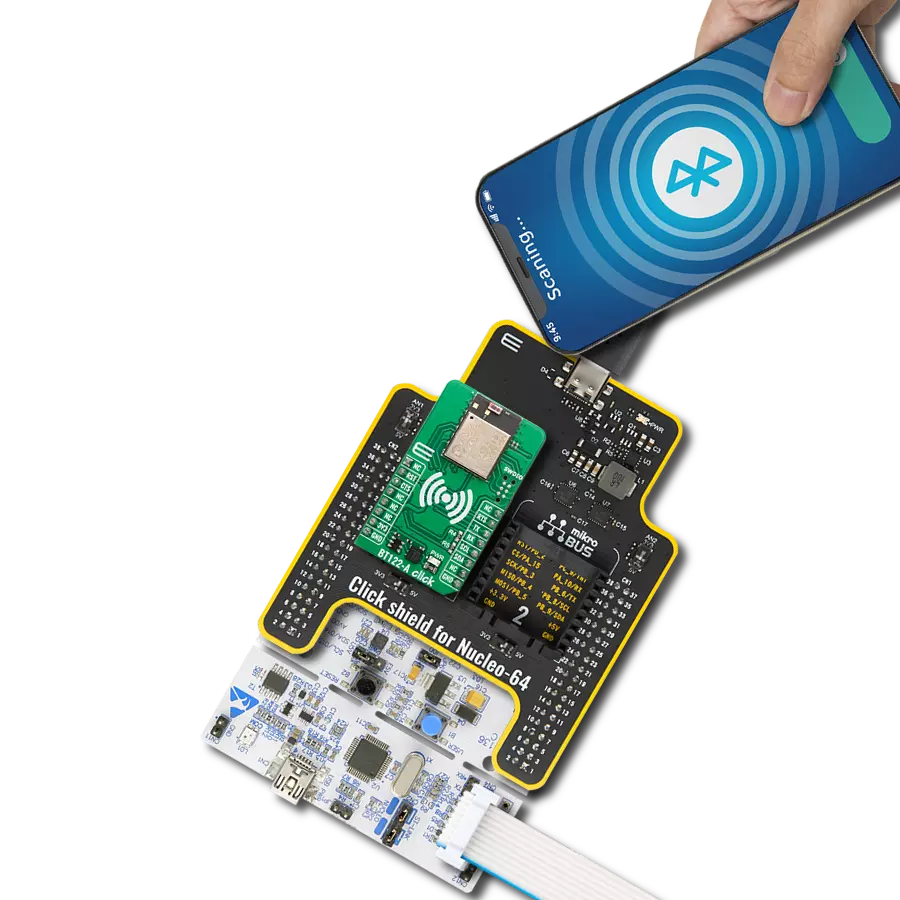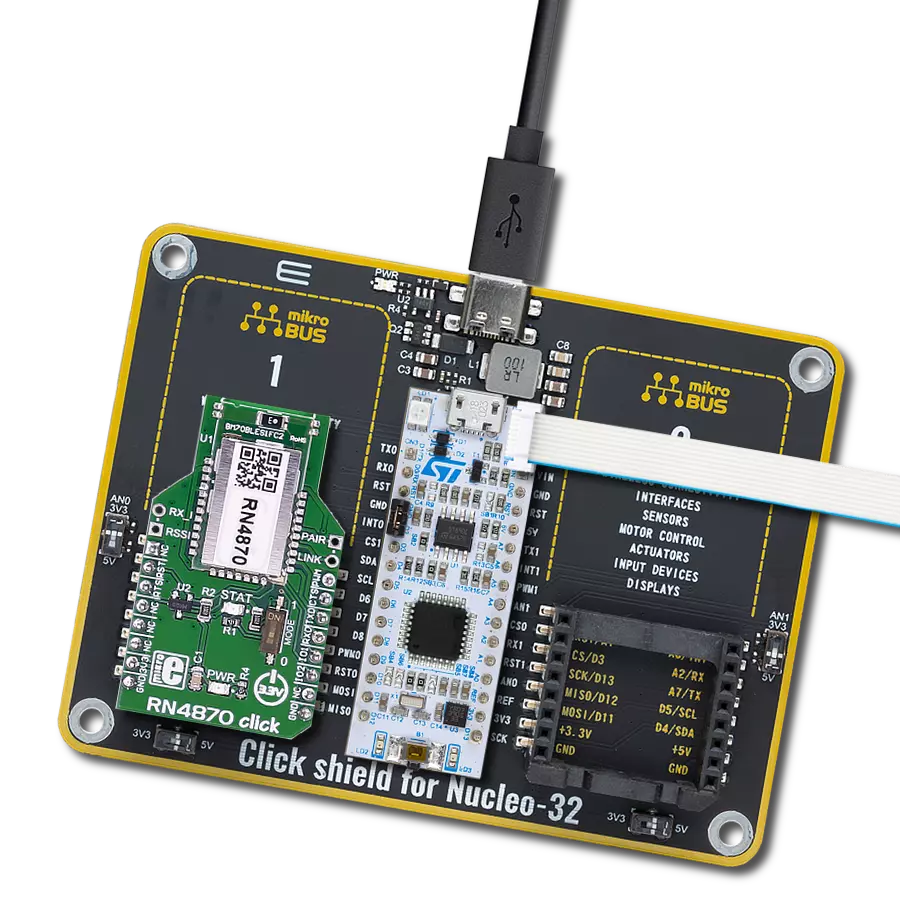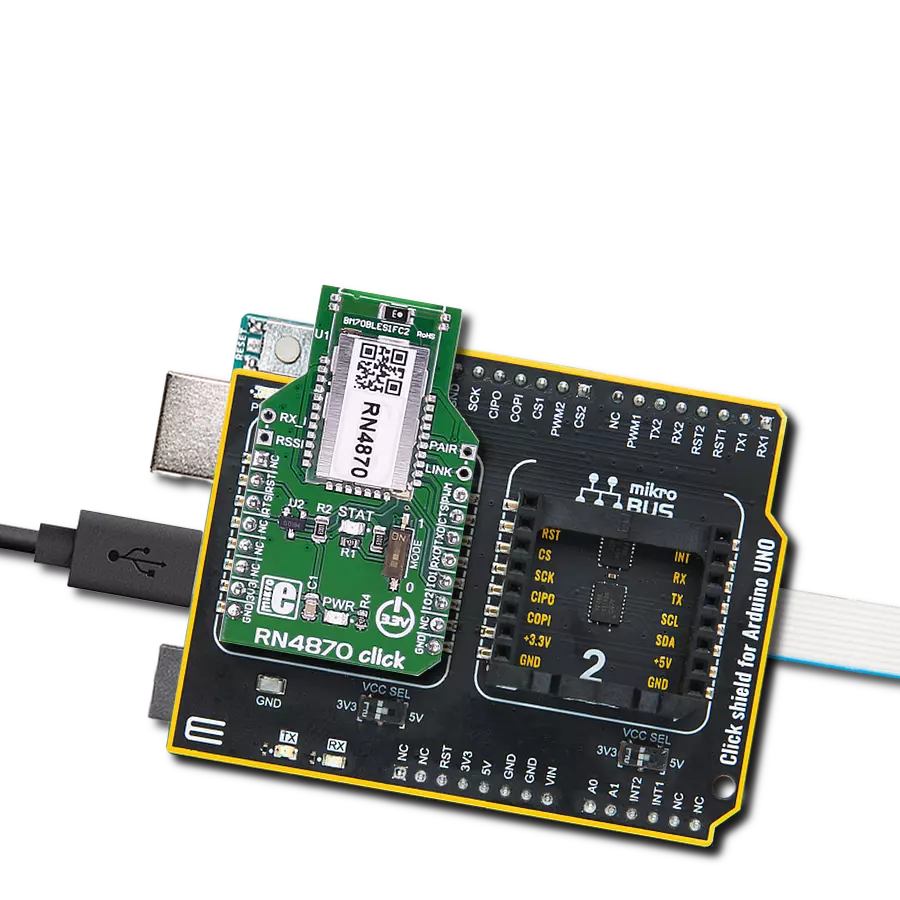Provide high-performance and secure Bluetooth Low Energy (BLE) 5.3 wireless connectivity for various Internet-of-Things (IoT) applications
A
A
Hardware Overview
How does it work?
LYRA 24P Click is based on the LYRA 24P (453-00145R), a secure, high-performance wireless module from Ezurio designed for line-powered IoT devices operating on Bluetooth networks. The LYRA 24P module is a highly integrated, high-performance system with all the necessary hardware components to enable 2.4GHz wireless connectivity. Based on the Series 2 EFR32BG24 SoC (32-bit ARM® Cortex®-M33 core at 39MHz), it enables Bluetooth® Low Energy (BLE) 5.3 connectivity, delivering exceptional RF performance and energy efficiency (+19.6dBm TX output power). It features industry-leading Secure Vault® technology (Lyra 24P module supports Secure Vault High) and futureproofing capabilities. Secure Vault is a collection of technologies providing state-of-the-art security and upgradability features to protect and futureproof IoT devices against costly threats, attacks, and tampering. A dedicated security CPU enables the Secure Vault functions, isolating cryptographic functions and data from the Cortex-M33 core. The LYRA 24P is a complete solution that offers fully upgradeable software stacks and global regulatory certifications. It is suitable for a broad range of applications, including
smart home devices, lighting, building automation and security, gateways, digital assistants, and Bluetooth mesh low-power nodes. The main module power supply is 3.3V from the 3V3 mikroBUS™ power rail, automatically supplied via the R6 resistor. It can also be powered via the AP7331, a fixed-3.3V output voltage low-dropout linear regulator. This Click board™ is based on the 453-00145R module but is also compatible with other LYRA 24P modules. The module includes a built-in antenna and operates in the 2.4GHz ISM frequency band, from 2402 to 2480MHz. Additionally, it has an unpopulated connector for an external 2.4GHz antenna connection, suitable for module variants with an RF pin for an external antenna only, such as the 453-00148. Communication between the LYRA 24P and the host MCU is established through a UART interface, using standard UART RX and TX pins and hardware flow control pins (CTS/RTS). The module communicates at 115200bps by default, allowing efficient data exchange. The board also includes a reset (RST) button/pin for resetting the module and a Boot (BT) button/pin used to determine when execution of the bootloader is required. Upon
reset, execution of the bootloader begins. When the Boot button is pressed, the bootloader continues execution, facilitating firmware updates via the UART. When released, the bootloader stops execution and passes control to the main application firmware. The LYRA 24P also supports hardware debugging via a 4-pin JTAG or 2-pin serial-wire debug (SWD) interface through the J1 header. This header includes two additional pins, the PTIF and PTID pins, providing a true PHY-level packet trace interface that captures packets non-intrusively to monitor and log device and network traffic without burdening processing resources in the module's SoC. These signals are a powerful debugging tool, especially when used with other hardware and software development tools. This Click board™ can be operated only with a 3.3V logic voltage level. The board must perform appropriate logic voltage level conversion before using MCUs with different logic levels. Also, it comes equipped with a library containing functions and an example code that can be used as a reference for further development.
Features overview
Development board
Clicker 2 for Kinetis is a compact starter development board that brings the flexibility of add-on Click boards™ to your favorite microcontroller, making it a perfect starter kit for implementing your ideas. It comes with an onboard 32-bit ARM Cortex-M4F microcontroller, the MK64FN1M0VDC12 from NXP Semiconductors, two mikroBUS™ sockets for Click board™ connectivity, a USB connector, LED indicators, buttons, a JTAG programmer connector, and two 26-pin headers for interfacing with external electronics. Its compact design with clear and easily recognizable silkscreen markings allows you to build gadgets with unique functionalities and
features quickly. Each part of the Clicker 2 for Kinetis development kit contains the components necessary for the most efficient operation of the same board. In addition to the possibility of choosing the Clicker 2 for Kinetis programming method, using a USB HID mikroBootloader or an external mikroProg connector for Kinetis programmer, the Clicker 2 board also includes a clean and regulated power supply module for the development kit. It provides two ways of board-powering; through the USB Micro-B cable, where onboard voltage regulators provide the appropriate voltage levels to each component on the board, or
using a Li-Polymer battery via an onboard battery connector. All communication methods that mikroBUS™ itself supports are on this board, including the well-established mikroBUS™ socket, reset button, and several user-configurable buttons and LED indicators. Clicker 2 for Kinetis is an integral part of the Mikroe ecosystem, allowing you to create a new application in minutes. Natively supported by Mikroe software tools, it covers many aspects of prototyping thanks to a considerable number of different Click boards™ (over a thousand boards), the number of which is growing every day.
Microcontroller Overview
MCU Card / MCU

Architecture
ARM Cortex-M4
MCU Memory (KB)
1024
Silicon Vendor
NXP
Pin count
121
RAM (Bytes)
262144
Used MCU Pins
mikroBUS™ mapper
Take a closer look
Click board™ Schematic

Step by step
Project assembly
Software Support
Library Description
This library contains API for LYRA 24P Click driver.
Key functions:
lyra24p_write_command- This function writes a desired command by using UART serial interface.lyra24p_write_cmd_param- This function writes a desired command, command value, prefix and parameter by using UART serial interface.lyra24p_inquire_command- This function writes a desired inquire command, command value and enable/disable quote by using UART serial interface.
Open Source
Code example
The complete application code and a ready-to-use project are available through the NECTO Studio Package Manager for direct installation in the NECTO Studio. The application code can also be found on the MIKROE GitHub account.
/*!
* @file main.c
* @brief LYRA 24P Click Example.
*
* # Description
* This example demonstrates the use of LYRA 24P Click board by processing
* the incoming data and displaying them on the USB UART.
*
* The demo application is composed of two sections :
*
* ## Application Init
* Initializes the driver and performs a factory reset.
* In the next step, the demo app requests the LYRA module name, software version,
* and MAC address and sets the local device name,
* sets the module into VSP mode and start advertising.
*
*
* ## Application Task
* Reads and processes all incoming data and displays them on the USB UART.
*
* ## Additional Function
* - static void lyra24p_clear_app_buf ( void )
* - static void lyra24p_log_app_buf ( void )
* - static err_t lyra24p_process ( lyra24p_t *ctx )
* - static void lyra24p_check_response ( uint8_t *rsp )
*
* @note
* We have used the BLE Scanner smartphone application for the test.
*
* @author Nenad Filipovic
*
*/
#include "board.h"
#include "log.h"
#include "lyra24p.h"
// Demo device name
#define DEVICE_NAME "LYRA 24P Click"
// Application buffer size
#define APP_BUFFER_SIZE 200
#define PROCESS_BUFFER_SIZE 200
// Response timeout
#define RESPONSE_TIMEOUT 100000
static lyra24p_t lyra24p;
static log_t logger;
static uint8_t app_buf[ APP_BUFFER_SIZE ] = { 0 };
static int32_t app_buf_len = 0;
/**
* @brief LYRA 24P clearing application buffer.
* @details This function clears memory of application buffer and reset its length.
* @note None.
*/
static void lyra24p_clear_app_buf ( void );
/**
* @brief LYRA 24P log application buffer.
* @details This function logs data from application buffer to USB UART.
* @note None.
*/
static void lyra24p_log_app_buf ( void );
/**
* @brief LYRA 24P data reading function.
* @details This function reads data from device and concatenates data to application buffer.
* @param[in] ctx : Click context object.
* See #lyra24p_t object definition for detailed explanation.
* @return @li @c 0 - Read some data.
* @li @c -1 - Nothing is read.
* See #err_t definition for detailed explanation.
* @note None.
*/
static err_t lyra24p_process ( lyra24p_t *ctx );
/**
* @brief LYRA 24P response check.
* @details This function checks for response and displays the status of response.
* @param[in] rsp Expected response.
* @return Nothing.
*/
static void lyra24p_check_response ( uint8_t *rsp );
void application_init ( void )
{
log_cfg_t log_cfg; /**< Logger config object. */
lyra24p_cfg_t lyra24p_cfg; /**< Click config object. */
/**
* Logger initialization.
* Default baud rate: 115200
* Default log level: LOG_LEVEL_DEBUG
* @note If USB_UART_RX and USB_UART_TX
* are defined as HAL_PIN_NC, you will
* need to define them manually for log to work.
* See @b LOG_MAP_USB_UART macro definition for detailed explanation.
*/
LOG_MAP_USB_UART( log_cfg );
log_init( &logger, &log_cfg );
log_info( &logger, " Application Init " );
// Click initialization.
lyra24p_cfg_setup( &lyra24p_cfg );
LYRA24P_MAP_MIKROBUS( lyra24p_cfg, MIKROBUS_1 );
if ( UART_ERROR == lyra24p_init( &lyra24p, &lyra24p_cfg ) )
{
log_error( &logger, " Communication init." );
for ( ; ; );
}
lyra24p_hw_reset( &lyra24p );
Delay_ms ( 500 );
lyra24p_write_command( &lyra24p, LYRA24P_CMD_AT );
lyra24p_check_response( LYRA24P_RSP_OK );
Delay_ms ( 500 );
lyra24p_write_command( &lyra24p, LYRA24P_CMD_AT );
lyra24p_check_response( LYRA24P_RSP_OK );
Delay_ms ( 500 );
lyra24p_inquire_command( &lyra24p, LYRA24P_CMD_ATI,
LYRA24P_ATI_ARG_DEV_NAME,
LYRA24P_QUERY_DIS );
lyra24p_check_response( LYRA24P_RSP_OK );
Delay_ms ( 500 );
lyra24p_inquire_command( &lyra24p, LYRA24P_CMD_ATI,
LYRA24P_ATI_ARG_FW_VER,
LYRA24P_QUERY_DIS );
lyra24p_check_response( LYRA24P_RSP_OK );
Delay_ms ( 500 );
lyra24p_inquire_command( &lyra24p, LYRA24P_CMD_ATI,
LYRA24P_ATI_ARG_BT_ADDR,
LYRA24P_QUERY_DIS );
lyra24p_check_response( LYRA24P_RSP_OK );
Delay_ms ( 500 );
lyra24p_write_cmd_param( &lyra24p, LYRA24P_CMD_ATS,
LYRA24P_ATS_ARG_DEVNAME_FORMAT,
LYRA24P_PREFIX_SYMBOL_SET_VAL,
LYRA24P_ATS_VAL_DEVNAME );
lyra24p_check_response( LYRA24P_RSP_OK );
Delay_ms ( 500 );
lyra24p_set_device_name( &lyra24p, DEVICE_NAME );
lyra24p_check_response( LYRA24P_RSP_OK );
Delay_ms ( 500 );
lyra24p_inquire_command( &lyra24p, LYRA24P_CMD_ATPS,
LYRA24P_PREFIX_SYMBOL_ZERO,
LYRA24P_QUERY_EN );
lyra24p_check_response( LYRA24P_RSP_OK );
Delay_ms ( 500 );
lyra24p_write_command( &lyra24p, LYRA24P_CMD_ATLADV );
lyra24p_check_response( LYRA24P_RSP_OK );
Delay_ms ( 500 );
lyra24p_write_command( &lyra24p, LYRA24P_CMD_ATLVSP );
lyra24p_check_response( LYRA24P_RSP_OK );
Delay_ms ( 500 );
}
void application_task ( void )
{
if ( LYRA24P_OK == lyra24p_process( &lyra24p ) )
{
lyra24p_log_app_buf( );
lyra24p_clear_app_buf( );
Delay_ms ( 100 );
}
}
int main ( void )
{
/* Do not remove this line or clock might not be set correctly. */
#ifdef PREINIT_SUPPORTED
preinit();
#endif
application_init( );
for ( ; ; )
{
application_task( );
}
return 0;
}
static void lyra24p_clear_app_buf ( void )
{
memset( app_buf, 0, app_buf_len );
app_buf_len = 0;
}
static void lyra24p_log_app_buf ( void )
{
for ( int32_t buf_cnt = 0; buf_cnt < app_buf_len; buf_cnt++ )
{
log_printf( &logger, "%c", app_buf[ buf_cnt ] );
}
}
static err_t lyra24p_process ( lyra24p_t *ctx )
{
uint8_t rx_buf[ PROCESS_BUFFER_SIZE ] = { 0 };
int32_t overflow_bytes = 0;
int32_t rx_cnt = 0;
int32_t rx_size = lyra24p_generic_read( ctx, rx_buf, PROCESS_BUFFER_SIZE );
if ( ( rx_size > 0 ) && ( rx_size <= APP_BUFFER_SIZE ) )
{
if ( ( app_buf_len + rx_size ) > APP_BUFFER_SIZE )
{
overflow_bytes = ( app_buf_len + rx_size ) - APP_BUFFER_SIZE;
app_buf_len = APP_BUFFER_SIZE - rx_size;
memmove ( app_buf, &app_buf[ overflow_bytes ], app_buf_len );
memset ( &app_buf[ app_buf_len ], 0, overflow_bytes );
}
for ( rx_cnt = 0; rx_cnt < rx_size; rx_cnt++ )
{
if ( rx_buf[ rx_cnt ] )
{
app_buf[ app_buf_len++ ] = rx_buf[ rx_cnt ];
}
}
return LYRA24P_OK;
}
return LYRA24P_ERROR;
}
static void lyra24p_check_response ( uint8_t *rsp )
{
uint32_t timeout_cnt = 0;
lyra24p_clear_app_buf( );
lyra24p_process( &lyra24p );
while ( ( 0 == strstr( app_buf, rsp ) ) &&
( 0 == strstr( app_buf, LYRA24P_RSP_ERROR ) ) )
{
lyra24p_process( &lyra24p );
if ( timeout_cnt++ > RESPONSE_TIMEOUT )
{
lyra24p_clear_app_buf( );
log_error( &logger, " Timeout!" );
}
Delay_ms ( 1 );
}
Delay_ms ( 100 );
lyra24p_process( &lyra24p );
if ( strstr( app_buf, rsp ) )
{
lyra24p_log_app_buf( );
}
else if ( strstr( app_buf, LYRA24P_RSP_ERROR ) )
{
log_error( &logger, " Command!" );
}
else
{
log_error( &logger, " Unknown!" );
}
}
// ------------------------------------------------------------------------ END
Additional Support
Resources
Category:BT/BLE

































